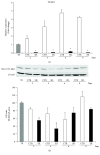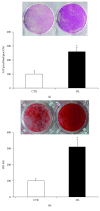NURR1 Downregulation Favors Osteoblastic Differentiation of MSCs
- PMID: 28769982
- PMCID: PMC5523352
- DOI: 10.1155/2017/7617048
NURR1 Downregulation Favors Osteoblastic Differentiation of MSCs
Abstract
Mesenchymal stem cells (MSCs) have been identified in human dental tissues. Dental pulp stem cells (DPSCs) were classified within MSC family, are multipotent, can be isolated from adult teeth, and have been shown to differentiate, under particular conditions, into various cell types including osteoblasts. In this work, we investigated how the differentiation process of DPSCs toward osteoblasts is controlled. Recent literature data attributed to the nuclear receptor related 1 (NURR1), a still unclarified role in osteoblast differentiation, while NURR1 is primarily involved in dopaminergic neuron differentiation and activity. Thus, in order to verify if NURR1 had a role in DPSC osteoblastic differentiation, we silenced it during all the processes and compared the expression of the main osteoblastic markers with control cultures. Our results showed that the inhibition of NURR1 significantly increased the expression of osteoblast markers collagen I and alkaline phosphatase. Further, in long time cultures, the mineral matrix deposition was strongly enhanced in NURR1-silenced cultures. These results suggest that NURR1 plays a key role in switching DPSC differentiation toward osteoblasts rather than neuronal or even other cell lines. In conclusion, DPSCs represent a source of osteoblast-like cells and downregulation of NURR1 strongly prompted their differentiation toward the osteoblastogenesis process.
Figures




References
-
- Murray P. E., About I., Franquin J. C., Remusat M., Smith A. J. Restorative pulpal and repair responses. Journal of the American Dental Association (1939) 2001;132(4):482–491. - PubMed
LinkOut - more resources
Full Text Sources
Other Literature Sources

